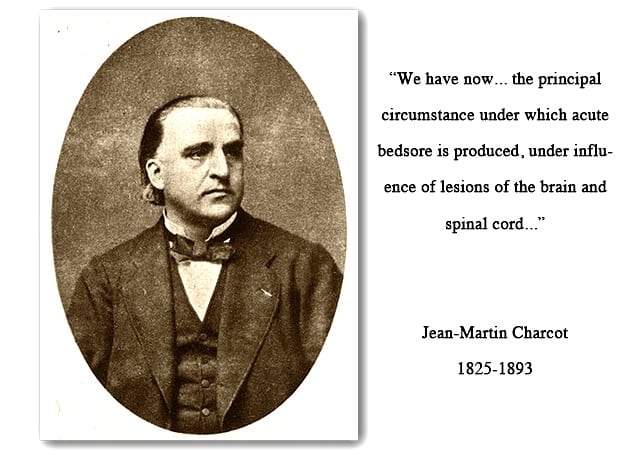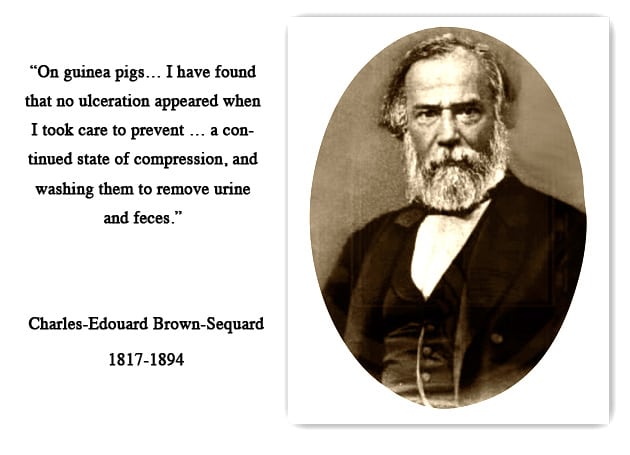
This post gives another preview of what I will be covering in my upcoming webinar entitled History of Pressure Ulcers & Wound Care: Past, Present, & Future, sponsored by the National Pressure Ulcer Advisory Panel. Some years ago while browsing in an antiquarian bookstore I opened a volume entitled Lectures on the Diseases of the Central Nervous System by Jean Martin Charcot published in 1877. Among the yellowed pages was an illustration of a necrotic sacral pressure ulcer. I purchased the book, and subsequently learned that I held in my hand the beginnings of the modern “avoidable-unavoidable” controversy on pressure ulcers and published my findings in the Journal of the American Geriatrics Society.

Dr. Charcot was one of the greatest physicians of the 19th Century, and described medical and neurologic syndromes that still bear his name. He worked in Paris where he headed the Salpêtrière, a chronic disease hospital that gained notoriety during the French Revolution when it was the site of an infamous massacre of French aristocrats. Charcot believed that pressure ulcers were an unavoidable result of damage to the brain or spinal cord because of “neurotrophic fibers” that connected the skin directly to the central nervous system. Charcot wrote:
“I have often been a witness to this fact, occurring among the aged persons in this hospital, and I have been many times able to satisfy myself that pressure on the spot occupied by the eruption did not here play an essential part.”
Charcot had an illustrious opponent by the name of Henri Brown-Sequard who tried to disprove Charcot’s neurotrophic theory of skin ulceration with experiments on small animals. In 1853 Brown-Sequard wrote:
“On guinea pigs, upon which the spinal cord was cut in the dorsal region, and on pigeons, upon which the spinal cord was destroyed from the fifth costal vertebra to its termination, I have found that no ulceration appeared when I took care to prevent any part of their bodies from being in a continued state of compression, and of washing them many times a day to remove the urine and feces…”
 This was an amazing and unique time when two of the greatest minds in medicine were concerned about bedsore pathogenesis, but unfortunately pressure ulcers dropped off the medical map for over a century. It took the demographic change toward an aging society to revive the discussion on pressure ulcers and cause the medical profession to refocus on their importance. This demographic change was ushered in by improvements in public hygiene and medical advances that prolonged the human lifespan and allowed people to live longer with multiple comorbidities.
This was an amazing and unique time when two of the greatest minds in medicine were concerned about bedsore pathogenesis, but unfortunately pressure ulcers dropped off the medical map for over a century. It took the demographic change toward an aging society to revive the discussion on pressure ulcers and cause the medical profession to refocus on their importance. This demographic change was ushered in by improvements in public hygiene and medical advances that prolonged the human lifespan and allowed people to live longer with multiple comorbidities.
Today there is renewed controversy as to whether pressure ulcers are avoidable or unavoidable, particularly in the “pay for performance” era. Most authorities agree that pressure ulcers are a quality indicator, yet few will say that all pressure ulcers are avoidable. The expert consensus published by the National Pressure Ulcer Advisory Panel stated that “not all pressure ulcers are avoidable.” In 2010, the Centers for Medicare and Medicaid Services (CMS) enacted a “no-pay” policy for hospital acquired pressure ulcers on the assumption that pressure ulcers are reasonably preventable using currently available clinical practice guidelines.
Certainly there are medical factors that cause certain pressure ulcers to be unavoidable. Some believe that the key to unavoidability is in the process of dying, and you can read more about the Kennedy Terminal Ulcer and Skin Changes at Life’s End (SCALE). I believe that these arguments have validity, but there are also factors apart from the dying process that lead to unavoidable pressure ulceration including forced immobility, pre-existing illnesses, and hemodynamic factors that impact adversely on blood supply to skin and soft tissues.
It is my belief that understanding history gives insight into principles we use every day in today’s practice. Indeed, some things that we think are new are actually thousands of years old. I hope you can join me in this webinar, to register please click on the link below. Attendance is limited to 1000, so it’s best to sign up soon. If you cant make the date, or if the attendance is full, don’t worry as the webinar will be archived HERE on the NPUAP website.
Register for this webinar HERE.
* * * * * * * * * * * * *
Related posts:
Wound Healing Products: From Ancient to Modern Mythology
Wounds of a Boxer: Medical Secrets from Ancient Rome
Jean Martin Charcot’s Lecture on Pressure Ulcers: An Important Historical Document
World Wide Pressure Ulcer Prevention Day
Government Data Sheds Doubt Upon Pressure Ulcers as a Quality Indicator
Pressure Ulcer as “Never Event”: Fact or Myth?
.
